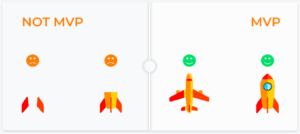The ABCs of Lean Development for MVP: A Guide to Faster, More Efficient Product Creation
Lean Development methodology is a popular approach to product creation that can help you build a Minimum Viable Product (MVP) faster and more efficiently. But what is Lean Development, and how can it help you create a successful MVP? This guide will break down the basics of Lean Development and how to use it for MVP development. By the end, you’ll understand the key concepts of Lean Development and be able to apply them to your own project. So let’s get started!
What Is Lean Development Mvp, And What Are Its Benefits For Startups?
Lean Development is a methodology that was created to help businesses reduce waste and increase efficiency. The Lean Development MVP, or minimum viable product, is the simplest version of a product or service that can be used to achieve the desired outcome. This means creating a product with the fewest features possible to quickly and cheaply develop and test with customers. The goal is to gather feedback early so businesses can make informed decisions about which features to include in the final product. By starting with a lean MVP, businesses can save time and money while still delivering a high-quality product to their customers.

Lean development is a popular approach to software development that focuses on creating minimal viable products (MVPs) to quickly test and iterate on new features, reduce the risk of failure, and optimize for efficiency. In the context of startups, there are numerous benefits to using a lean development approach when building your product or service.
One of the most significant advantages of lean development is that it allows you to test your product or service with real users quickly, gather feedback, and make any necessary adjustments before investing significant time and resources into further development. This means you can avoid wasting time and money on features or designs that may not ultimately resonate with your target audience.
Additionally, lean development helps reduce the risk of failure by allowing you to prototype early and test often. By constantly refining and improving your MVP based on user feedback, you can minimize the chances of building something that isn’t aligned with what your customers want or need.
Another key benefit of lean development is that it promotes an agile mindset among team members, encouraging them to be responsive, flexible, and open to change to adapt quickly as new challenges arise. This enables teams to stay focused on their core objectives without getting bogged down by unnecessary details or bureaucracy.
Overall, lean development is an excellent choice if you are looking for a fast and efficient way to develop software for your startup. By prioritizing user feedback and iterating rapidly based on emerging trends in your industry, you can create an MVP that meets the needs of both your customers and your business goals.
How to create a Lean Development MVP strategy for your startup
One of the most important steps in launching a startup is creating a lean development MVP strategy that will help you build an effective product quickly and efficiently. This involves identifying the core features of your product, prioritizing them based on user demand and other factors, and then incorporating these features into your initial product launch.
To create a successful lean development MVP strategy for your startup, you should start by brainstorming all possible features you could include in your product. These might include things like different types of content or functionality like social media integration, search capabilities, and more.

Next, you should prioritize these features based on user demand and other factors, such as how critical they are to the overall success of your product. You may also want to consider consulting with potential users or investors to get their input on which features would be most valuable or appealing to them.
Once you’ve identified your top-priority features, developing them for your initial product launch is time. This can typically be done using a combination of web or mobile apps and software tools that can help speed up the development process. Your goal should be to release an initial version of your product that includes at least some key features that users can interact with and provide feedback on.
Overall, creating a lean development MVP strategy is essential in building a successful startup. By focusing on crafting an effective product quickly and accurately assessing user needs and demands along the way, you can significantly increase the likelihood of achieving success with your startup venture.
Lean Development MVP strategies for different types of businesses
- One common lean development MVP strategy for businesses of all types is to create a “minimum viable product” that focuses on the core features or functions of the business while leaving out any unnecessary or extraneous features.
- This approach can help to streamline the development process and allow businesses to focus on developing their core offerings rather than getting bogged down in secondary or peripheral features that may not be necessary for their end users.
- Another effective lean development MVP strategy is to create a “lean startup,” which involves testing different ideas and concepts quickly and iterating on them based on user feedback.
- This approach allows businesses to get feedback from potential customers and make course corrections as needed without investing too much time or resources in any concept or idea.
- Other popular strategies for using lean development MVP strategies include leveraging agile project management techniques, designing minimal viable products that can be implemented quickly with limited resources, and engaging in continuous user testing to identify areas for improvement and optimization.
The importance of customer feedback in the Lean Development MVP process
Customer feedback is an essential part of the Lean Development MVP process, as it allows developers to incorporate user input into their product before it is released to the public. By soliciting feedback from potential customers, developers can identify and fix any bugs or issues in their products, helping them to create a high-quality final product that meets the needs and expectations of their audience.
In addition to simply identifying issues with a product, customer feedback can also inform changes and improvements that should be made to enhance the overall user experience. Through engaging with customers, developers can gather insights on what features they would like to see added or removed from a product, as well as information on how they can make their products easier to use or navigate.
Overall, customer feedback is critical for ensuring that developers create products that genuinely meet the needs of their target audience. By incorporating this feedback into the development process early on, developers can ensure a successful launch and build a loyal customer base who will help drive future product development efforts.
10 Tips for implementing a successful Lean Development MVP strategy
- Begin by defining your target market and the problem or need you are trying to solve for them. This will help you determine what kind of MVP you should build, as well as how to prioritize development efforts and resources.
- Develop a clear roadmap for your Lean Development MVP strategy, outlining key milestones along the way and timelines for achieving each one. This will help ensure that you stay on track and keep the momentum going throughout the process.
- Tap into existing networks and resources, such as other developers, mentors, and industry experts who can provide valuable guidance and feedback on your MVP strategy.
- Be willing to iterate quickly on your MVP based on user feedback and data analysis, making tweaks or even wholly revamping features as needed to optimize performance and results.
- Set up regular checkpoints with stakeholders throughout the process to keep everyone informed about progress, challenges, successes, and roadblocks as they arise. This will help ensure that any issues get resolved quickly before they become too disruptive or costly to overcome later on down the line.
- Emphasize collaboration among team members from start to finish of your Lean Development MVP strategy, utilizing a combination of individual roles (e.g., designers, developers) as well as cross-functional teams if necessary (e.g., product managers working closely with UX/UI designers).
- Establish strong communication channels with customers from day one of your MVP development process to gain valuable insights into what they really want from your product or service at various stages of its lifecycle. This can also support ongoing product refinement post-launch based on ongoing customer feedback down the line.
- Leverage A/B testing whenever possible during development to evaluate different options or features at different stages of implementation so that you can make data-driven decisions about what works best for users and customers alike over time.
- Prioritize speed over perfection when it comes to launching your MVP – this means taking risks upfront in order to get your product out there sooner rather than later while still maintaining quality standards throughout the process at every stage of development and deployment alike.
- Finally, be patient with yourself as well as others involved in implementing a successful Lean Development MVP strategy – it takes time and practice to develop expertise in this area, so be sure to give yourself room for learning along the way while recognizing that mistakes are inevitable but also learning opportunities for future iterations of your strategy moving forward.
MVP mistakes to avoid
When launching a new product, the pressure to succeed can be immense. After all, this is your chance to make a splash in the marketplace and gain some early adopters and momentum.

One popular way to do this is through the Minimum Viable Product (MVP) approach. The MVP is a version of your product that has just enough features to be able to test it with users and get feedback. This feedback can then be used to improve the product before launch.
The MVP approach can be very practical, but there are also some pitfalls to avoid if you want to make the most of it. Here are four mistakes to avoid when launching an MVP:
1. Not Defining Your Target User
One of the most common mistakes when launching an MVP is not having a clear target user in mind. The MVP approach is all about building something that appeals to a specific group of users and then using their feedback to improve the product.
If you don’t have a clear target user in mind, building something that appeals to them will be challenging. This can lead to your MVP being completely off-target and not providing the valuable feedback you need.
2. Not Prioritizing Features
Another mistake often made when launching an MVP is not prioritizing features correctly. When starting out, it’s tempting to try and include as many features as possible in your MVP. However, this can often lead to a cluttered and confusing product.
Instead, you should focus on including only the most essential features in your MVP. This will make it simpler and easier to use, which will in turn, make it more appealing to your target users.
3. Not Getting Feedback Early Enough
Another mistake often made with MVPs is not getting feedback early enough. The whole point of an MVP is to get feedback from users so that you can improve the product before launch. However, if you wait too long to get this feedback, it will be too late to make any significant changes.
Ideally, you should aim to get feedback from users as early as possible in the development process. This will give you the most time to incorporate their feedback and make the necessary changes.
4. Not Iterating Quickly Enough
Finally, one of the most common mistakes when launching an MVP is not iterating quickly enough. The MVP approach is about continual improvement, which means you must be prepared to make changes to your product regularly.
If you’re not iterating quickly enough, you’ll miss out on valuable feedback, and your product will fail to improve. Iterate as quickly as you can, and always be open to making changes based on user feedback.
Avoiding these four mistakes will help you launch a successful MVP and get the valuable feedback you need to improve your product. Keep these tips in mind, and you’ll be well on launching a successful product.
How much does an MVP cost?
The cost of an MVP depends on several factors, including the size of your team, the complexity of your product, and the amount of time you have to develop it. A basic MVP can be created for a few thousand dollars, but more complex products can cost tens or even hundreds of thousands of dollars to develop.
Examples of MVP:
Some common examples of MVPs include:
-A basic landing page with just enough information to capture leads
-A single feature on a larger website or app
-A physical product with only the essential features
MVPs can be incredibly valuable for startups and small businesses that need to validate their ideas quickly and efficiently. By starting small and gradually adding more features, they can avoid wasting time and money on products that no one wants or needs.
What are some other examples of MVPs that you have seen or used? Share your thoughts and experiences in the comments below!








